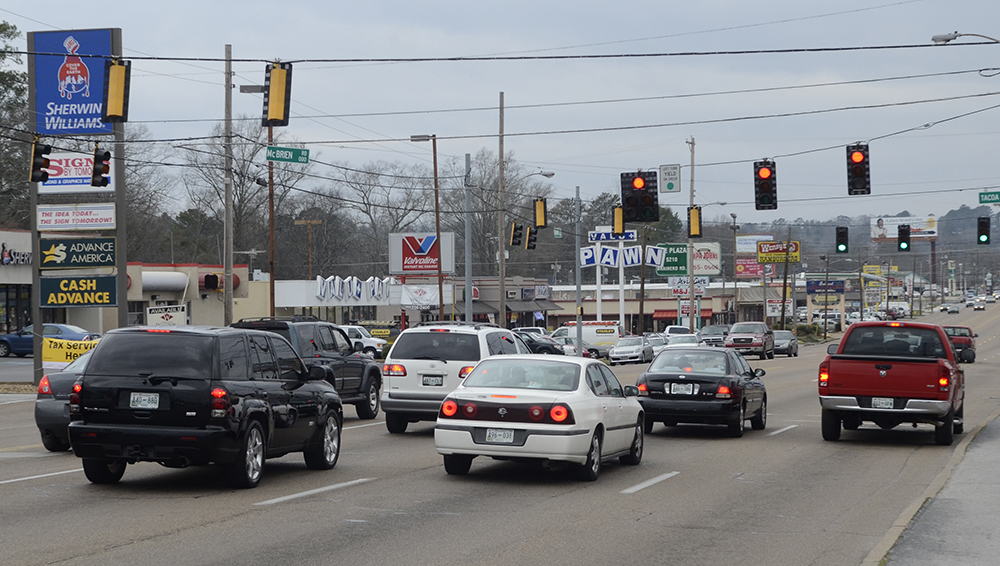If you didn't have to pay strict attention to the traffic while you are driving on the narrow Brainerd Road lanes between Spring Creek Road and East Brainerd Road, you might notice the plethora of telephone poles, signs, buildings, light poles and parking lots.
It's a hot mess.
City planners want to fix all that, and they hope their presentation of the Brainerd Road Overlay Zone to the Chattanooga/Hamilton County Regional Planning Commission Monday night was a beginning.
The primary objectives of "Brainerd ... a Vision for Today," the community's master plan adopted by the City Council in 2011, are to improve the corridor's looks, to address traffic congestion on Brainerd Road and to make the corridor more pedestrian, bike and transit friendly.
The zoning plan will be voted on by the Planning Commission on June 9, presented to the Chattanooga City Council in June and voted on by the City Council in July, according to Regional Planning Agency senior planner Sarah Weeks Robbins.
Since the plan involves exclusively private property, nothing will change for existing businesses along the one-mile corridor unless they trigger a change that involves the city's Land Development Office. Then, along with whatever updates the businesses want to make, they also will have to comply with the specifics of the new plan.
Otherwise, the plan would involve only new development along the stretch of Brainerd Road.
It would require new buildings to have specific zones similar to, but broader than, those put in when the IHOP, Chick-fil-A and Applebees restaurants went in. Immediately adjacent to Brainerd Road would be a 6-foot, grassy Street Edge Zone with trees and landscaping. To the outside of that zone would be a 12-foot Bike/Pedestrian Zone. And to the outside of that, depending on the placement of the building, would be a 0- to 8-foot Storefront/Building Zone.
Parking would be to the rear of the building where possible, and to the side of the building where not possible.
"The community wants action now," said Robbins, who made the presentation to the Planning Commission. "They want this policy codified."
All of the changes make good sense for new development. Trees along the sides of the street would beautify the area -- it couldn't get much worse -- and a wider bike/pedestrian zone would promote more modes of transportation along the corridor and even more shopping.
Where the rub will occur is when existing businesses trigger the changes. Many of the businesses may be hanging on by a thread but want to expand when it seems feasible. Not only will they have to have the money to expand, but they will have to expend thousands of dollars more to comply with the new regulations.
Actions such as painting an existing building would not trigger the changes, but actions such as change in use of the property and expansions encompassing 25 percent or less of the lot would.
Those businesses then would have to comply with the Street Edge and Pedestrian/Bike Zone requirements, landscape their parking lot and provide a screen edge (landscaping) between the Pedestrian/Bike Zone and existing parking, consolidate curb cuts if they have more than is mandated, add appropriate shade trees for every seven parking spaces within 40 feet of space, adjust signage to new regulations, afford specified bicycle parking and use only appropriate materials on any expansion.
In many cases, Robbins admitted, parking will be reduced.
"It's pretty obvious," she said, "you're taking a good chunk of property."
That's a lot for existing small businesses to swallow if they want to grow and in order that the corridor look better. It would be prudent for the Planning Commission and the City Council to consider that and ask appropriate questions when the time comes.
The plan, if implemented all at once, offers the possibility of reducing traffic. But it won't be implemented all at once, so the area's worst problem -- traffic in the narrow lanes -- would still exist.
Robbins said that issue will require additional study and involve the Tennessee Department of Transportation -- because the state owns the right-of-way -- and the city's transportation department. In any case, she said, it will have no bearing on the Brainerd Road Overlay Zone presently being considered.

